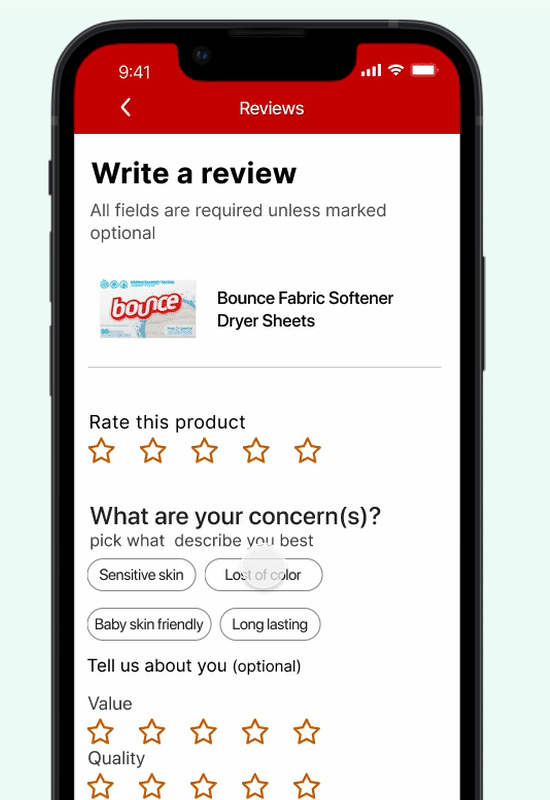Personalizing reviews for beauty products to better assist shoppers
My role: UX/UI Designer
Timeline: January 2023 - April 2023 (2 week sprints)
Team of: A11y designer, Content designer, User researcher, 2 developers, Product manager
Platforms & tools
- iOS
- aOS
- Web
- Figma
- Miro
- usertesting.com
- Adobe Illustrator
Context
Beauty shopping relies heavily on reviews, but existing systems often exclude diverse skin tones, hair types, and personal preferences. CVS wanted to reimagine the review experience by making it:

- Inclusive – Accurately representing all skin tones, hair textures, and identities.
- Customizable – Letting users describe themselves in ways that feel natural.
- Actionable – Helping shoppers find products that truly work for them.
As the UX/UI designer, I led the effort to research, prototype, and test a scalable solution across CVS’s platforms.
Research & Discovery
Understanding Inclusivity in Beauty To ensure our approach respected diverse identities, we analyzed industry standards for skin and hair classification:
The decision was to use the following scale for hair and skin complexion
- F.I.A hair Hair Type - for identifying hair volume
- Andrew Walker Hair Type System - for identifying curl pattern
- Braden Scale - for skin sensory perception
The decision was to use the following scale for skin complexion
- Von Luschan’s Scale (VLS) - for tones and undertones
- Braden Scale - for skin sensory perception
Exploring other companies reivew experience
Since CVS holds multiple brands that use different scales for their products, I wanted to see how other companies handle that experience, as well as review experienc, identifying skin complexion and conditions and hair types. When looking at other companies, I focused on some products. For hair - shampoo, and for skin foundations and skin wash.
Broke down the Competitive analysis for learning what companies do for hair, skin foundations, and reviews.

What was learn?
- There are multiple systems for hair that identify curl pattern, texture, and volume.
- There are skin tones and undertones.
- Using AI to aid on analyzing skin tone and hair type
- Existing shoppers do believe that reviews help with their shopping experience.
The goals for the project:
- To make writing and reading reviews customizable
- Not offend people or isolate group(s) of potential shoppers
- See how we can make the experience inclusive with existing scales for describing skin and hair
- Find methods to help people create more reviews.
User Flow
Iteration
Mid fidelity prototype
Brainstorming layouts for writing and reading reviews - iOS exmaple
With the information gathered from the research, I’ve updated a mid and high-fidelity prototype for writing and viewin focusing on the following products:
- Shampoo
- Foundation
- Lipstick
- Face cleanser


High-fidelity prototypes for writing & reading reviews - iOS
Sumbitting reviews for face foundation

Viewing rating and reviews

User testing
10 particpant / Unmoderated / usertesting.com


Some information that was noticed
- 7/10 struggled with vague foundation shade names.
- 8/10 loved the inclusive approach but wanted clearer multi-selection.
- 3/10 (Caucasian participants) noted they rarely saw their hair type excluded, reinforcing the need for broader testing.
Refined UI to better communicate optional/multi-select fields.
Impact & Outcomes- 22% increase in review engagement (projected).
- 44% potential boost in conversions from better-matched reviews.
- Accessible handoff – Worked with developers to ensure cross-platform consistency.
With the infromation gather, I adjusted the prototype.
Development
Ensuring a transition from design to implementation Working closely with accessibility specialists and developers, we structured the handoff to address:
- Multi-platform consistency: Provided tailored specs for iOS, Android, and Web (e.g., chip/pill interactions, adaptive layouts).
Accessibility compliance:
- Color contrast ratios for skin/hair selection chips.
- Screen reader labels for dynamic UI (e.g., "Selected: Medium Cool Undertone").
- API integrations: Clarified how third-party reviews would merge with CVS’s system.
We did set up times for QA and or if we did not think about an error or something that connected to the API from the other sites that CVS uses to get outside reviews.






